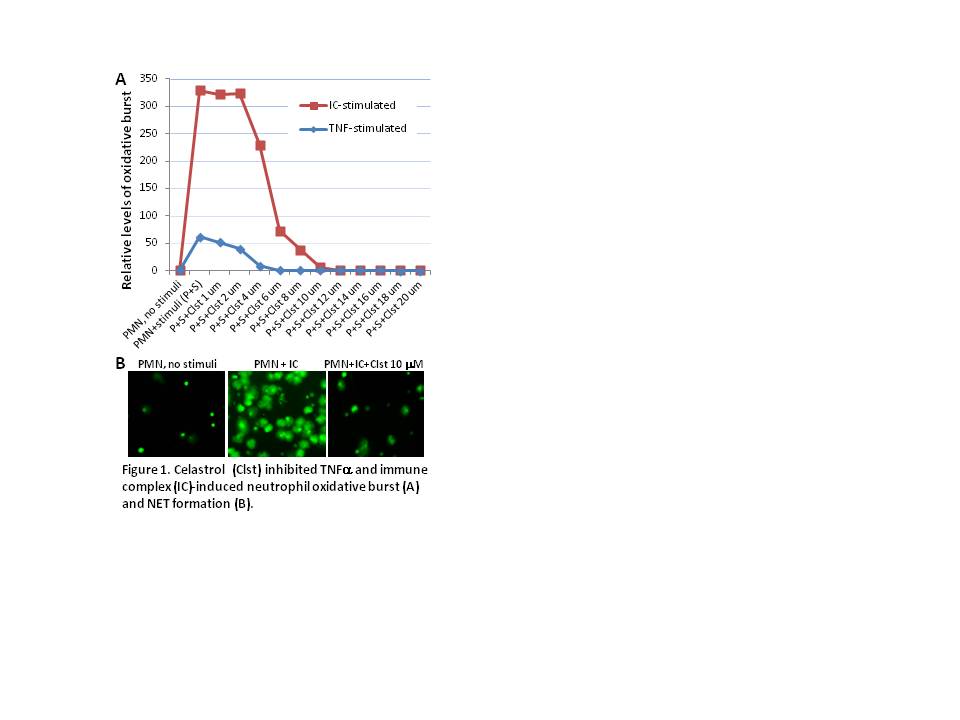Session Information
Session Type: Late-Breaking Abstracts
Background/Purpose: , Neutrophils provide the frontline of defense against invading pathogens. However, neutrophils also contribute to the development of autoimmune diseases. Recent studies suggest that neutrophils and neutrophil extracellular traps (NET) play an active role in driving autoimmunity and tissue injury in vasculitis, rheumatoid arthritis (RA) and systemic lupus erythematosus (SLE). Thus, inhibition of neutrophil activation may provide an effective strategy to prevent and treat autoimmune diseases. The purpose of this study was to test if celastrol, a triterpene isolated from anti-rheumatic Tripterygium wilfordii (also known as the Thunder God Vine), can inhibit NET formation.
Methods: , Freshly isolated neutrophils from blood samples of healthy controls and patients with RA or SLE were cultured in vitro in the presence of different concentrations of celastrol or vehicle only. Neutrophils were stimulated with tumor necrosis factor alpha (TNFα, 100 ng/ml) or immune complex (ovalbumin:anti-ovalbumin complex, 10 µg/ml) to induce neutrophil activation. Oxidative burst was measured by flow cytometry for the levels of oxidized rhodamine 123. NET was measured by staining the released chromatin DNA with SytoxGreen; and visualized by fluorescent microscopy and qualified by a fluorescence polarization microplate reader.
Results: Celastrol significantly inhibited TNFα and immune complex-induced oxidative burst and NET formation from neutrophils isolated from healthy controls and patients with RA or SLE (p ≤ 0.001 by Paired t-Test and n ≥ 5 for each group of subjects; n = 18 in total). Celastrol can completely inhibit TNFα-induced neutrophil activation at 6 µM (IC50 ≈ 3 µM) and immune complex-induced neutrophil activation at 12 µM (IC50 ≈ 5 µM). Celastrol also inhibited the spontaneous NET formation from neutrophils isolated from RA and SLE patients while the spontaneous NET formation from healthy control derived neutrophils was generally undetectable. To elucidate the underlying mechanisms of celastrol, we found that celastrol treatment resulted in decreased phosphorylation of extracellular-signal-regulated kinase (ERK) and NF-kappa-B inhibitor alpha (IkBα), suggesting the involvement of ERK pathway and the transcription factor NF-kB. Celastrol treatment also led to decreased citrullination of histone H3 examined by western blot analysis.
Conclusion: Celastrol potently inhibits TNFα and immune complex-induced neutrophil oxidative burst and NET formation at concentrations normally used in pharmaceuticals. The inhibition of neutrophil activation and NET formation represents a new pathway for the anti-inflammatory function of celastrol. Our studies implicate that celastrol is a promising drug candidate for the treatment of different inflammatory and autoimmune diseases involving neutrophils.
Disclosure:
C. D. Koehn,
None;
Y. Yu,
None;
Y. Yue,
None;
S. Li,
None;
M. P. Hearth-Holmes,
None;
G. M. Thiele,
None;
T. R. Mikuls,
None;
J. R. O’Dell,
None;
L. W. Klassen,
None;
Z. Zhang,
None;
K. Su,
None.
« Back to 2013 ACR/ARHP Annual Meeting
ACR Meeting Abstracts - https://acrabstracts.org/abstract/celastrol-a-triterpene-from-tripterygium-wilfordii-inhibits-neutrophil-extracellular-trap-formation/

